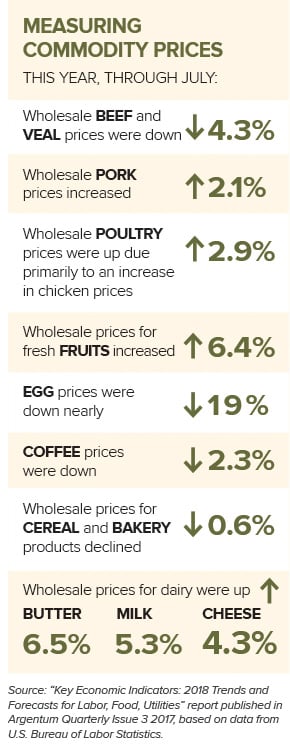The elements of operational expenditure are discrete, quantifiable, and eminently manageable. Labor. Food. Energy.
Each can be addressed as a unique problem set. The brightest operators—along with the sharpest vendors—have come up with a whole menu of options when it comes to managing costs in each of these critical areas, from waste in the kitchen, to LED lighting, to hiring strategies that help shrink overtime.
Labor Costs
Just as people are at the very heart of the senior living enterprise, labor costs lie at the heart of operational expenses. Senior living is a hands-on endeavor; it’s labor-intensive, which means that managing the “people” cost can make a sizable difference to the bottom line.
It’s not a line item that is easily finessed since labor comprises multiple factors. Regular hours may appear relatively easy to control, but this often proves more complex than one would suppose. Pay rate is determined not just by what you’re willing to offer but by external factors such as prevailing market demand. And overtime is the wild card, the fluctuating factor that often sends labor costs spiraling upward.
“It’s a challenge,” admits Earl Parker, chief operating officer at Commonwealth Senior Living, which operates 22 communities in Virginia with a mix of independent living, assisted living, and memory care. “And it becomes more and more challenging as the demand for people wanting to fill those positions grows, and the supply shrinks.”
Parker’s “Hire for Heart” program courts future caregivers from the ranks of Target and Chick-Fil-A employees, people who may lack experience in caring for seniors, “but who have the desire to do more and to make more of a difference,” he said.
 Commonwealth spends $300 to $500 per person to train the “Hire for Heart” staff up to direct care associate certificate status. The small up-front cost gets recouped quickly. “We are not paying for the highly-experienced caregiver who would demand a higher rate. On average, it’s probably 15 percent lower than someone with a CNA, and we also get a 50 percent better retention on those people, versus people who come to us already with those certifications,” Parker said.
Commonwealth spends $300 to $500 per person to train the “Hire for Heart” staff up to direct care associate certificate status. The small up-front cost gets recouped quickly. “We are not paying for the highly-experienced caregiver who would demand a higher rate. On average, it’s probably 15 percent lower than someone with a CNA, and we also get a 50 percent better retention on those people, versus people who come to us already with those certifications,” Parker said.
While Commonwealth uses hiring strategies to manage labor costs, others look to reduce big-ticket overtime expense, especially through the use of digital technologies.
Take for instance PointClickCare Technologies, whose cloud-based software helps manage the senior living workforce. The company aims to address an efficiency gap that is prevalent across senior living: That is, the failure to align staffing with resident acuity.
Many senior living providers allot staffing based on resident headcount—an ever-changing, and often inaccurate measure. “If you staff based on occupancy, you are saying that every resident has the same needs, and we know that is not the case,” said Travis Palmquist, vice president and general manager, senior living at PointClickCare. A better plan is to build schedules around a service-level assessment, and that’s something software can do more effectively than the conventional spreadsheet.
“You should have an idea how many minutes each service requires. Most communities have a pretty good idea: the average bath requires 25 minutes, the average medication management takes so long, room cleaning takes so long,” he said. With an accurate assessment, “you get an idea of how many services they are scheduled to deliver, how many are billable, and then you are literally aligning staffing with acuity.”
With greater clarity, a senior living community can fine-tune staffing levels on a given shift, and also ensure it is billing for all services delivered.
Building a solid culture also trims turnover costs. “Communities are competing ferociously for the best staff and the best leaders, and you need to keep the best when you find them. If you can get the right group in there and keep them, that’s where you reduce your labor cost,” he said.
Paired with thoughtful hiring and training practices, he said, this kind of software-based scheduling can significantly reduce both regular hours and overtime expense.
 Food Costs
Food Costs
In order to better manage food costs, don’t think about food costs. For senior living dining directors, the key is to approach the cost equation from a resident satisfaction point of view. Everything else flows from there, said Gottfried Ernst, vice president of hospitality for Harbor Retirement Associates.
To trim food expenses, it’s important to determine what residents like to eat. Then, build menus off of that and cost drivers like waste, spoilage, and over-ordering all begin to fall away.
Menu choices drive the bottom line. “You need to have a menu that is well-balanced, with highs and lows in terms of items that are more or less expensive. You need a menu that allows you to cross-utilize products: You can have broccoli one day and broccoli-cheese soup the next day,” he said.
The menu likewise determines what you keep in the cupboard, but to make the most of a good menu, you need to keep a close watch on that inventory. “You have to keep very good control on what you purchase versus what you are serving. So you check product when it is being received to be sure food is in proper condition. Then you make sure product is stored at the right temperature, so you get the longest shelf life out of every product,” Ernst said.
All of these details are significant at a time when food costs are on the rise. After registering five consecutive annual increases between 2009 and 2014—a total increase of 25 percent—the “Producer Price Index for All Foods” declined in 2015 and 2016, but prices are climbing again. The “Producer Price Index for All Foods” rose in six of the first seven months of 2017, according to the “Key Economic Indicators: 2018 Trends and Forecasts for Labor, Food, Utilities” report.
Good inventory practices can pare back waste. It helps, too, for the staff to have an overall awareness that waste is an issue.
Morrison Community Living is a food vendor to over 350 senior living communities. In addition to product, the company provides its clients with a “Waste Not” program that encourages waste awareness.
Each kitchen station gets a receptacle to gather waste, which is weighed and reported at the end of the week. “If the produce waste this week is 10 pounds, by next week or a month from now you want it to be five pounds,” said Calvin Neal, senior vice president of culinary and retail for Morrison Community Living. “This keeps waste front of mind for every employee, which makes people more cautious to not overcook the bacon, and to make sure that things are wrapped, labeled, and dated properly.”
Food tracking likewise helps cut down on waste; it’s that resident satisfaction piece again. If you track what people are eating (or what food is being returned uneaten) you can better manage quantities across the food service process. A modern point-of-sale system can help with this, or a dining director can keep a tally on a traditional spreadsheet. The important thing is to keep the record. “A lot of people don’t do this. They just eyeball it,” Ernst said. “The people who don’t track end up over-ordering and food goes to waste.”
“If you have people in the kitchen washing dishes, they see all of the food that comes back, so when I talk about waste I start with them. They can tell you exactly how much people are eating. This is a key person in detecting and tracking waste,” Ernst said.
Servers play an equally vital role. “They can tell you what residents like or dislike. You can tell them about selling special items that are in season or that you need to get rid of because the shelf life is expiring,” he said.
This issue of what the staff sees and knows takes us right back to the starting point of food service cost management: resident satisfaction.
Food costs and resident satisfaction go hand in hand. If one of these metrics is askew, chances are the other one is too, and it’s probably time to make some adjustments.
Energy Costs
 Senior living communities have good reason to be mindful of energy expenses. Already a major cost center, power is expected to get more expensive in the coming year, with electricity rising 1.2 percent nationally and as much as 4.2 percent by region, according to the “Key Economic Indicators: 2018 Trends and Forecasts for Labor, Food, Utilities” report.
Senior living communities have good reason to be mindful of energy expenses. Already a major cost center, power is expected to get more expensive in the coming year, with electricity rising 1.2 percent nationally and as much as 4.2 percent by region, according to the “Key Economic Indicators: 2018 Trends and Forecasts for Labor, Food, Utilities” report.
In order to minimize energy costs, Brightview Senior Living swaps in LEDs for conventional lighting any time a property comes up for renovation. The senior living provider does this not only because it makes economic sense, but also to secure LEED certification, a mark of a green-friendly building.
“They last longer and use far less energy than traditional lighting, and the market has changed to where they are now competitively priced,” said Kristian Spannhake, project director at Brightview. “As an owner-developer, we look at the cost today against the replacement cost. We want a building that runs as cost-effectively as possible and LEDs accomplish that. They are energy efficient now, and because they have a 20-year lifespan, we are not spending money later on new bulbs or the labor associated with replacing bulbs.”
Experts say it makes sense to move an entire community to LED lighting rather than changing out bulbs one at a time. By taking a property-wide inventory and doing a wholesale changeover, it’s possible to get the bulbs at a lower price and also take advantage of incentives and rebates from state and federal sources.
There are some incremental wins to be had beyond lighting. Heating, ventilation, and air conditioning (HVAC), for instance, is where a big percentage of energy dollars are spent. But this gets tricky. An HVAC upgrade can be very expensive and can disrupt resident life during the transition, and the returns on such projects aren’t always very high.
Still, it makes sense to look at heating and cooling as a possible place to cut costs.
Brightview, for instance, is transitioning from Packaged Terminal Air Conditioner (PTAC) technology to more modern Variable Refrigerant Flow (VRF) in its new buildings. The systems are expensive—$6,000 to $9,000 more per unit compared to PTAC—but require less hardware, are more aesthetically pleasing, and cost far less to operate.
Less expensive, and intriguing to some, are intelligent control systems, the rising variety of sensor systems that help to automatically regulate the interior environment.
While sensor systems have improved in recent years, Spannhake is still treading with caution. “Some are easier to use than others. The platform may be more straightforward for the maintenance director to manage. Some are far more convoluted and require more training,” he said. “Some also lack the ability for us to control at the actual local level. Say the residents are playing Mahjong in a different room tonight. At the room level, at 8 p.m., is the system smart enough to let me take control back?”
Still, he’s looking to automation to yield big returns over time. “In the past, you might have had lights full on, 24/7. Now you can leave on those lights, but you can dim them. Or a light that someone used to forget in the library and it stayed on all night, now it goes off automatically,” he said. “That has to be an improvement.”
Across energy, food, and labor, it’s clear that controlling operational expenses is no small task, nor it is easily achieved. But it’s also clear that with the right technologies, with thoughtful management and diligent oversight, it is possible to make incremental improvements that ultimately bolster the bottom line.




